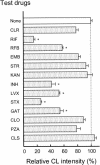Interaction of antimycobacterial drugs with the anti-Mycobacterium avium complex effects of antimicrobial effectors, reactive oxygen intermediates, reactive nitrogen intermediates, and free fatty acids produced by macrophages
- PMID: 15155211
- PMCID: PMC415576
- DOI: 10.1128/AAC.48.6.2132-2139.2004
Interaction of antimycobacterial drugs with the anti-Mycobacterium avium complex effects of antimicrobial effectors, reactive oxygen intermediates, reactive nitrogen intermediates, and free fatty acids produced by macrophages
Abstract
The profiles of the interaction of antimycobacterial drugs with macrophage (MPhi) antimicrobial mechanisms have yet to be elucidated in detail. We examined the effects of various antimycobacterial drugs on the anti-Mycobacterium avium complex (MAC) antimicrobial activity of reactive oxygen intermediates (ROIs), especially of an H(2)O(2)-halogen (H(2)O(2)-Fe(2+)-NaI)-mediated bactericidal system, reactive nitrogen intermediates (RNIs), and free fatty acids (FFAs), which are known as central antimicrobial effectors of host MPhis against mycobacterial pathogens. We have found that certain drugs, such as rifampin (RIF), rifabutin (RFB), isoniazid (INH), clofazimine (CLO), and some fluoroquinolones, strongly or moderately reduced the anti-MAC activity of the H(2)O(2)-Fe(2+)-NaI system, primarily by inhibiting the generation of hypohalite ions and in part by interfering with the halogenation reaction of bacterial cell components due to the H(2)O(2)-Fe(2+)-NaI system. This phenomenon is specific to the H(2)O(2)-Fe(2+)-NaI system, since these drugs did not reduce the anti-MAC activity of RNIs and FFAs. From the perspective of the chemotherapy of MAC infections, the present findings indicate an important possibility that certain antimycobacterial drugs, such as rifamycins (RIF and RFB), INH, CLO, and also some types of fluoroquinolones, may interfere with the ROI-mediated antimicrobial mechanisms of host MPhis against intracellular MAC organisms.
Figures



References
-
- Akaki, T., K. Sato, T. Shimizu, C. Sano, H. Kajitani, S. Dekio, and H. Tomioka. 1997. Effector molecules in expression of the antimicrobial activity of macrophage against Mycobacterium avium complex: roles of reactive nitrogen intermediates, reactive oxygen intermediates, and free fatty acids. J. Leukoc. Biol. 62:795-804. - PubMed
-
- Akaki, T., H. Tomioka, T. Shimizu, S. Dekio, and K. Sato. 2000. Comparative roles of free fatty acids with reactive nitrogen intermediates and reactive oxygen intermediates in expression of the anti-microbial activity of macrophages against Mycobacterium tuberculosis. Clin. Exp. Immunol. 121:302-310. - PMC - PubMed
-
- Brestel, E. P. 1985. Co-oxidation of luminol by hypochlorite and hydrogen peroxide implications for neutrophil chemiluminescence. Biochem. Biophys. Res. Commun. 126:482-488. - PubMed
-
- Chapman, A. L., M. B. Hampton, R. Senthimohan, C. C. Winterbourn, and A. J. Kettle. 2002. Chlorination of bacterial and neutrophil proteins during phagocytosis and killing of Staphylococcus aureus. J. Biol. Chem. 277:9757-9762. - PubMed
Publication types
MeSH terms
Substances
LinkOut - more resources
Full Text Sources

